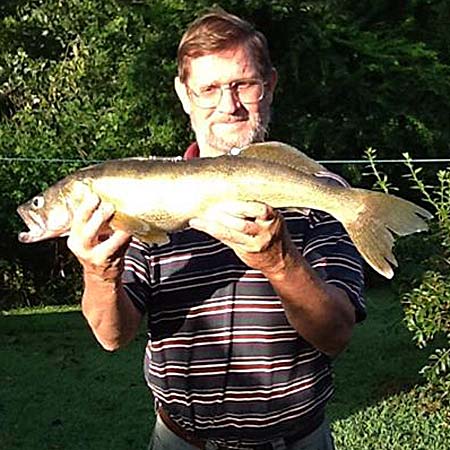Opinion: A fisherman’s plea for responsible fishing of Kentucky waterways
By MARK HEINZ
Guest Columnist
Tuesday, March 12, 2019 — Like many Kentuckians, I learned to fish with a cane pole in farm ponds as soon as I learned how to walk. For me, that was 60-odd years ago. There were three farm ponds on my grandparents’ farm in Oldham County. They all held good numbers of bluegill and bass.
We lived close to Louisville. When I started driving, the range of my fishing expanded to neighboring counties: Guist Creek Lake and Lake Shelby in Shelby County. Lake Jericho in Henry County. Deam Lake and Hardy Lake up in Indiana.
Sometimes we traveled a bit farther to fish. The Wolf Creek Dam tailwater below Lake Cumberland was a perennial favorite. In late May, early June we camped and fished there for three or four days at a time. There was no creel or size limit on crappie. Before noon we usually had about 100 crappie—all that we wanted to clean in one day. We ate crappie every night and took hundreds of crappie fillets home in coolers.
The size limit on largemouth bass was 10 inches, and the creel limit was 25 fish. When largemouth bass were spawning in Lake Jericho in the spring, we sometimes caught and kept a limit of 25 bass apiece. Fishermen were few, and fish were many.
NEW BREED OF FISHERMEN. When I was a kid, there were just two fishing shows on TV. Kentucky Afield first aired in 1953, the year before I was born. I wasn’t a big fan, because it featured both hunting and fishing, and I only cared about fishing. And then there was Gadabout Gaddis. Beginning in the early ‘60s, Roscoe Vernon “Gadabout” Gaddis did a show called The Flying Fisherman. Born in 1896, Gaddis was a gentlemanly, grandfatherly pilot who flew his small plane to his fishing destinations. The shows were filmed without sound. Gaddis later added a laid-back, folksy narration. I loved old Gadabout Gaddis and his show.
In 1968, Bill Dance’s first fishing show aired on TV. His friends Roland Martin and Jimmy Houston soon followed with TV shows of their own. Together they formed a company called Th3 to sell their signature fishing lures and products.
Also in 1968, Forrest L. Wood developed and built the very first bass boat. By 1970, Ranger Boats sold 1,200 units. Wood organized bass fishing tournaments to advertise and sell his boats.
Bass fishing suddenly became big business. (Dance, Martin, Houston, and Wood are all multimillionaires now.) By the late 1980s, it seemed every “Bubba Jim Bob” who liked to drink beer and get away from his wife on weekends was on the lake “running and gunning” for bass. Numbers of bass fishermen ticked steadily upward throughout the ‘90s and into the new millennium. Competitive largemouth bass fishing carried over to other species. Now there are tournaments for crappie, walleye, striped bass, muskies, trout, catfish, bluegill, even carp.
More fishermen naturally led to fewer fish. Creel limits decreased and size limits increased. For the past 20 years I have lived at Nolin Lake. Here we have a 9-inch minimum size limit on crappie. There is a 15-inch minimum size limit on largemouth and smallmouth bass, (except one fish in the daily limit may be under 15 inches). The statewide daily creel limit on largemouth and smallmouth bass is six. The statewide daily creel limit on crappie decreased last year from 30 to 20.
FISH HOGS VS. CONSERVATION. Last year I heard a guy griping about the dwindling number of crappie here at Nolin Lake. He said years ago he and his wife always caught 1,000 crappie every spring, but this year they only caught 300. Assuming they eat only crappie and no other fish, 300 crappie per year should be plenty. Fish consumption guidelines recommend no more than one meal per week of panfish, like crappie. Six fish per week times 50 weeks equals 300 fish.
When crappie are on brush piles in the spring, some fishermen return to catch their limit day after day after day. As long as the crappie are biting, they keep fishing and catching. Why not leave a few fish for next time? At least leave a few fish to spawn and reproduce.
Sadly, fish are more vulnerable during the spawn. Female fish need more food to nourish their eggs. Male fish are more vulnerable too. Last spring I heard a guy boasting he caught 100 bluegills in a single nesting area. He thought it was okay, because most of the bluegills were males, not eggy females.
Male bluegills are critical to the spawning process. The male establishes a territory, and then constructs a nest. After courting one or more females, the male fertilizes the eggs. He then defends the developing eggs, larvae, and fry from predators, and he fans the nest to oxygenate it and keep it free of silt. A male bluegill will grab in his mouth anything close to his nest, making him easy to catch. But once the male is gone, the eggs have a very poor chance of survival.
There were seven kids in my family, plus mom and dad made nine hungry mouths to feed. Dad had a good job, but it wasn’t that good. My mom, who balanced the checkbook and shopped for groceries, always appreciated a good mess of fish. We always caught and kept as many fish as we legally could.
Nowadays, however, I practice conservation. Even when crappie are biting, I usually limit myself to 12 fish. Although I’m just 10 minutes away from good fishing, I rarely fish more than once a week. I typically keep one or two bags of fillets in the freezer. I don’t try to fill a big freezer with fish. We eat fish maybe two or three times a month.
WORDS MATTER. Our fisheries are managed and protected by the Kentucky Department of Fish and Wildlife Resources. When I think of resources, I think of coal and gas and oil and timber—things to be used and exploited—not fish and wildlife. (I don’t like the term Human Resources either. I prefer Personnel Department.) I propose the agency change its name to the Kentucky Department of Fish and Wildlife Management.
Fishing is often called a sport, a word that generally denotes competition. Obviously, there is competition among tournament fishermen. Some anglers believe they’re competing or contending with the fish. If an angler catches a fish, score one for the angler. If a fish gets off the hook and escapes, score one for the fish. That type of thinking is simply ridiculous. The fish doesn’t know it’s involved in a contest, or game. When it strikes a lure or inhales a minnow, it merely wants to eat. When it jumps and throws the hook, it’s struggling for its survival. It’s not trying to win anything, except for its freedom.
Fishing for me is not a sport. I never compete or contend with other anglers, or with fish. I consider fishing a pastime, or hobby. I enjoy the fresh air, the exercise, the scenery, and the wildlife more than the simple act of catching a fish. Enticing a fish to strike a lure and pulling a sharp steel hook into its face just for fun, or to win some kind of competition, is not my idea of good sport.
Contrary to what you might hear on TV, no fish is a monster. Landing a fish, regardless of its temperament and size, is no cause for a celebratory high-five. You’re not St. George slaying the dragon. You haven’t scored a touchdown, or hit a home run. You’ve used modern technology to hook and catch an innocent creature that was probably having a pretty good day until you came along and ruined it.
FISH ARE PEOPLE TOO. I like fish. When I was a kid, I wanted to become a marine biologist. I didn’t have much aptitude for math and science, so that didn’t happen. Still I like fish. I raise tropical fish in an indoor aquarium. I raise goldfish and minnows in a 12’ X 12’ pond I built in my backyard.
Of course, I don’t really believe fish are people too. I just wrote that to get your attention. I do believe that fish are like you and me and all living creatures: They wish to avoid pain, and they seek comfort. For example, a fish will move from water that’s too hot, or too cold. Fish must eat to live, just like us. They feel a strong and instinctive need to perpetuate their specie, just like us.
For decades I’ve watched creel limits decrease and size limits increase, yet fish populations continue to dwindle. Clearly, state-imposed limits aren’t enough. Each and every one of us should help conserve our fisheries. Set reasonable limits on yourself. Don’t take more fish than you need. Respect the inherent rights of fish and all living creatures. If and when you take an animal’s life, be it fish or be it wildlife, be grateful, and a little sad.
Humankind has not woven the web of life.
We are but one thread within it.
Whatever we do to the web, we do to ourselves.
All things are bound together.
All things connect.
— Chief Seattle, 1854
Mark Heinz is a US Army veteran whose stories have appeared in the Army Times, Soldier, and Stars and Stripes. His fishing stories have appeared in Kentucky Afield, Midwest Outdoors, and Back Home in Kentucky. He lives at Nolin Lake with his wife and daughter.
-30-
.






